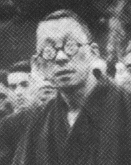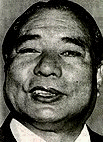 Beginings
1930-1960
Beginings
1930-1960 Beginings
1930-1960
Beginings
1930-1960
Makiguchi realised that his "Value Creation" theories were limited and that they could not change the human condition. He felt such lofty goals could only be achieved by what he considered to be a true religion. In 1928 he met a fellow educator named Sokei Mitani, a member of �the Nichiren Shoshu Buddhist religion's lay group Hokkeko. After many discussions with Mitani, �Makiguchi eventually took faith in Nichiren Shoshu, as did his close "disciple", a man named Josei Toda (1900-1958).
During the war, Japan's Shintoist millitary government insisted that the populace install Shinto Talismans (kamidana) within their homes. Although it went against Nichiren Shoshu beliefs to have Shinto shrines, the religion apparantly gave permission to it's members to fool the authorities into thinking that they had accepted this law. Due to a wartime fire at Nichiren Shoshu's head temple Daisekiji, most records of the era have been lost, but it appears that Nichiren Shoshu members could accept delivery of the talisman, but were not allowed to worship it. None-the-less Makiguchi & Toda decided to make a political stand against the government's ruling and were among many thousands of people, �jailed for similar reasons. Makiguchi died in jail, but Toda was released at the end of the war.
Upon his release Toda, who had maintained faith in Nichiren Shoshu Buddhism throughout his ordeal, decided to re-kindle the Soka Kyoiku Gakkai, but change it's purpose. Instead of being an educational group, he designated it as a Buddhist group belonging to Nichiren Shoshu's Hokkeko. And changed the name to simply "Soka Gakkai". Toda planned a widespread propagation campaign and feared that his efforts may incur some controversy. For this reason, in the 1952, he asked �Nichiren Shoshu's Chief Priest for permission to make Soka Gakkai a religious corporation, �independant of Nichiren Shoshu Hokkeko. This was permitted, but on three conditions : 1) That Soka Gakkai members must also be members of Nichiren Shoshu temples 2) That Soka Gakkai members must �follow the teachings of Nichiren Shoshu and 3) Soka Gakkai must protect the "Three Treasures" - the Buddha, the Law and the Priesthood. Toda, a devoted Nichiren Shoshu Buddhist readily agreed to these conditions as the basis of Soka Gakkai. Indeed, he once told Nichiren Shoshu's Chief Priest of the time : "If ever the Gakkai goes against the priesthood or interferes with it's internal affairs, please disband the Gakkai".
Before he passed away in 1958, Toda achieved his goal of having Soka Gakkai convert 700,000 people to Nichiren Shoshu. He also appointed his successor - Tsugio Ishida. However, as this appointment was not entirely public knowledge, a two year power struggle occurred after Toda's death. The wrangling was finally resolved, when youth division leader Daisaku Ikeda was became the new President of Soka Gakkai in 1960.
 The Ikeda Years 60's,
70's, 80's and 90's
The Ikeda Years 60's,
70's, 80's and 90's
Daisaku Ikeda's leadership has been a double edged sword for Soka Gakkai. During his tenure Gakkai put on millions of members - though detractors would say that that was more due to the efforts of members and the allure of Nichiren Shoshu Buddhism than the man imself. Despite refusing to accept contributions from members in the early daysSoka Gakkai became much affluent under his command. Soka Gakkai attrcted bad press under Toda for being very vigorous in it's evangelical propagation methods, but the really bad press came during the Ikeda years.
As a sort of precurser of what was to come, Ikeda got into serious trouble with Nichiren Shoshu for leading a gang of Soka Gakkai youth division members in the attacking of an 80 year old man, a priest, who they blamed for Toda & Makiguchi's imprisonment. As Toda was head of the Gakkai at this point, he accepted respnosibility and was banned from Daisekiji for two months. It is not known what role (if any) Toda played in organising the assault, but his humble apologies certainly seemed �sincere. Although he was the actual perpetrator of the violence, Ikeda appeared to get away with no punishment.
In 1960 Ikeda formed the Komeito (Clean Government) political party in Japan